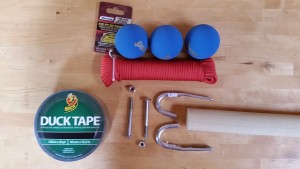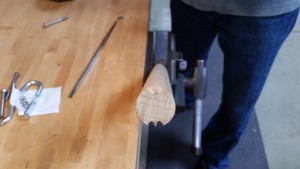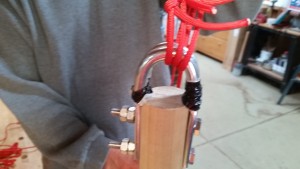You are reading the archive for the category: General
Filed as Classical Fencing, Destreza (Spanish swordplay), Fencing, Geek Stuff, General, Historical Fencing with Comments Off on Building a Flail Trainer
This is how we built a two-handed 3-headed flail trainer with parts you can find at your local hardware and sports store. The method described here isn’t the only way to build a flail and the training weapon here is experimental. If you build it there is every chance you could injure yourself with it if you get as crazy as my brother might. So… I warned you.
The parts list:
- 6-foot closet pole (1.8 meters)
- 2 matching screw-mounted rope hooks
- 2 bolts with matching nuts
- Nylon paracord
- Duct tape (of course)
- 3 racket balls

Flail parts laid out
The Measurements
Our flail has a 3-foot handle and three approximately 3-foot “chains” including the heads.
Instructions
1. Cut the closet pole down to size. (For our first flail we tried a length of 3 feet (0.9 meters). It worked fine but we’re thinking of making the next handle slightly shorter by about 4 inches for a total haft length of 32 inches (0.8 meters).)
2. Use the rope hook as a guide for marking your drill target. We chose to bring the hook as far down into the pole as possible to increase the strength of the trainer.

Use the Rope Hook as your Stencil for your Drill Guide

Marked and Ready for Drilling
3. Slowly drill all the way through the pole and remove any frayed edges.
4. Align the two Rope Hooks facing each other to form the “chain’s” looping anchor point on the flail. At this point you may want to remove some stock from the pole to ensure a snug fit by marking the end of the shaft and using a round file to remove the extra.

Marking the Head of the Flail to Remove Extra Stock

We will file that out

Filing out the Extra. (It’s easier if you use a vise.)

Stock Removed. Also, now it looks like the Bat symbol. (Batman would be proud to train with us.)
4. Now that you’ve created a perfect fit, fasten both Rope Hooks onto the shaft with the bolts so that they face each other to form a looping “chain” anchor point.

Two Rope Hooks makes a good loop.

Fastened Down Tight.
5. At this point you have created something dangerous with the exposed metal bolts. I recommend using a hacksaw to cut the exposed bolts off and then cover anything with sharp edges with a layer or two of tape. You want to minimize the possibility of cutting yourself if you accidentally hit yourself in the head.
6. Next, drill a hole through each of three racket balls.

Yep… That’s a hole clean through a racket ball.
7. Run your nylon paracord through the hole. To do this, we used fishing line.

Push a loop of fishing line through the holes and then insert your paracord into the loop on the far side. Pull it through and, “Tada!” it is threaded.

Success!
8. Tie the cord just underneath the flail head using a bowline knot. ( Click here to see how to tie this knot! )

Tie it with a bowline knot.
9. Tie it to the anchor point using the same bowline knot. (Repeat the process for all three flail heads.)
10. We used duct tape on the edges of the Rope Hook to avoid any grab on the nylon rope “chains”.

It doesn’t have to be beautiful.
The Completed Flail Trainer

Congratulations… you have given birth to a baby flail with a 3-foot shaft and 3-foot chains.
This is much lighter than an actual flail when you swing it around but you still get a scary amount of force with it such that hitting people is probably a terrible idea. While exercising the flail we found that swinging it at high speed didn’t seem to cause any problems with the racket balls but striking solid targets caused cracks around the drilled holes which would be eventual failure points.
Still, not bad for flail 1.0.
Filed as Destreza (Spanish swordplay), Fencing, General, Historical Fencing with no replies
“Montante, Montante, how will I learn to understand?”
Montante says, “Walk a mile of the rules with me in your hands.”
“Montante, Montante, how will I learn still more?”
Montante says, “When you’ve done a single mile then walk another four.”

A Collection of Greatswords
The Montante Mile: Martial Challenge
There is an aphorism that states, “You do not know another person until you have walked a mile in his shoes” and in this case we want to know the montante in the same way. There will be no partner or adversary. There will be no one keeping score or time. There will be you, your weapon, and one mile of work to be done.
The goal of this martial challenge is to gain personal knowledge of the forms and the usage of the weapon beyond merely an academic level. It is our hope that at some point during the challenge you and the weapon will find common cause and greater understanding through physical action as a form of learning and meditation.
The organizers will lay out a measured course and be available to teach a few simple traditional montante forms that will allow the challenger to move forward along the course. After that it’s merely a matter of the challenger using a few forms to travel a mile in laps on the course. You can use traditional forms, you can alter or combine forms, or you can use techniques from another tradition entirely. The challenge is in the doing.
The course will have lengths measured at 60 feet. You will pass a mile with 90 lengths and complete the challenge. If you break your challenge out into 3 days then 30 lengths per day will accomplish the goal. If you cannot reach the full mile you could aim for the Montante Medio at 45 lengths.
What happens when your conscious mind relaxes and you can listen to what the Montante is telling you? Perhaps you will find out in the Montante Mile.
Filed as Destreza (Spanish swordplay), Fencing, General, Historical Fencing with no replies
You need to know 14 actions for the system of single-handed swordplay described by the Destreza authors.
These fourteen actions are:
Defenses
- The Advantage of the Right Angle – The sword arm is extended forward at a right angle with the body such that the point menaces the adversary along a straight line. The arm should be extended but not locked. The defensive threat may be passive or it may be used actively to generate obedient motion from the adversary.
- Atajo – Subjection of the opposing steel from above with equal or greater degrees of strength in the engagement such that the adversary cannot strike you in a single movement. Neither the body nor the sword should participate in extremes. You will create a cross of the weapons by raising the point and lowering the hilt to intersect and capture the opposing weapon.
- Movement of Conclusion – The act of seizing the opponent’s hilt with your left hand.

Teaching an Atajo
Offenses
- The Thrust – A single movement attack which pierces the adversary’s body to wound with the point. Thrusts may be linear or circular. Thrusts may glide in opposition along the opponent’s weapon or may be delivered without touching the steel.
- The Half Cut – A two movement attack that cuts the opponent’s body with the edge which is prepared and delivered from the right side.
- The Half Reverse – A two movement attack that cuts the opponent’s body with the edge which is prepared and delivered from the left side.
- The Circular Cut – A three movement attack that cuts the opponent’s body with the edge which is prepared on the left side and delivered from the right side.
- The Circular Reverse – A three movement attack that cuts the opponent’s body with the edge which is prepared on the right side and delivered from the left side.
General Techniques (Spirals)
- General Technique of Narrowing – From an atajo on the inside line at the Defensive Medio, carry the opposing steel in a half circle counterclockwise to the outside low line and terminate by stepping to the right to deliver a gliding thrust to the chest.
- General Technique of Weak under Strong – From an atajo on the outside line at Defensive Medio, carry the opposing steel in a half circle clockwise to the inside low line and terminate by stepping to the right to deliver a thrust by detachment to the chest.
- General Technique of Weak over Strong – From an atajo on the inside line at Defensive Medio, carry the opposing steel in a complete circle counterclockwise to the inside high line and terminate by stepping to the right to deliver a thrust by detachment to the chest.
- General Technique of Line in Cross – From an atajo on the outside line at Defensive Medio, carry the opposing steel in a complete circle clockwise to the outside high line and terminate by stepping to the right to deliver a gliding thrust to the chest.
Note: The Generals can be combined together in such a way that the end of one may form the beginning of another without breaking the spiraling motion. It is perhaps more useful to envision the Generals as spirals solely defined by the line in which they terminate to deliver the attack rather than whether they are a half or full circle. Spirals may be used with engagement to transport the opposing weapon or to collect it in space and carry it to a new line.
Changes of Strength
- Movement of Increase – Changing the degree of strength in the engagement to increase leverage along the opposing weapon.
- Movement of Decrease – Changing the degree of strength in the engagement to decrease leverage along the opposing weapon.
Bonus:
You also need to know two of the Medios.
- Defensive Medio – A place, distance, and context in which you are far enough away from the threat to effectively defend yourself but from which you can begin to develop offense.
- Offending Medio – The place, distance, and context of the ideal strike from which you deliver a wound while simultaneously defending yourself. The Offending Medio is the perfect outcome you seek.
Filed as General with no replies
The election could go either way and we’re challenged to see the pieces on the board as they actually are and not as we wish they were. That being said, there are several indicators that Clinton has an advantage. One way of understanding the 2016 election is that there are significant differences between the cohorts of the two parties which we can break down into three key elements:
- Age
- Race
- Gender

Cartoon by Thomas Nast from Harper’s Weekly.
Age:
One useful way of looking at election demographics is by examining generations. The generations that form today’s voting blocs are:
- Silent Generation
- Median age ~75
- Shrinking cohort, very Republican, most reliable voters
- Baby Boomers
- Median age ~60
- Huge cohort, small GOP advantage, reliably votes
- Gen-X
- Median age ~45
- Small cohort, small Democratic advantage, reliably votes
- Millennials
- Median age ~20
- Largest cohort, very liberal, votes presidential elections
Up until recently the Silent generation was the power player at the table by uniting with the Baby Boomers to carry elections for the GOP. The Millennials are the new power player in town and when they vote, they unite with Gen-X to swing elections for the Democrats. Millennials (like all young people before them) do not typically vote in mid-terms or primaries which is why the GOP does better in mid-terms.
Conventional wisdom says voters get more conservative as they age but the actual data doesn’t support that. Instead, as the Silents and the Baby Boomers die, the GOP isn’t replacing them and their base atrophies. At the same time, the liberal base is larger than it has ever been before which is why very liberal candidates like Al Gore, Barack Obama, Hillary Clinton, and Bernie Sanders are even considerable on the national stage.
Analysis: Based on the generation gap in voting patterns and the size of the upcoming Millennial cohort Democrats have the edge.
Race:
The GOP has a very white base (89% of the GOP are white) and that is usually at the expense of the minority vote.
The Winners of the White Vote by Year:
- Nixon 1968 (Winner) – 68% of the white vote
- Ford 1976 (Loser) – 52% of the white vote
- Reagan 1980 (Winner) – 55% of the white vote
- Reagan 1984 (Winner)- 66% of the white vote
- Bush 1988 (Winner) – 59% of the white vote
- Bush 1992 (Loser) – 47% of the white vote
- Dole 1996 (Loser) – 46% of the white vote
- Bush 2000 (Winner) – 56% of the white vote
- Bush 2004 (Winner) – 57% of the white vote
- McCain 2008 (Loser) – 56% of the white vote
- Romney 2012 (Loser) – 57% of the white vote
Notice that no Democrat has won the white vote since Johnson but Democrats have won the popular vote in 1992, 1996, 2000, 2008, and 2012. As a percentage of the electorate the white vote is shrinking by about 1.5% every couple of years and the data indicates that minority voters have more voting power.
With white voting power diminishing a GOP candidate has to either grab a massive percentage of the white vote (Reagan 1984) or gather a larger percentage of the minority vote (Bush 2004). Consider that both McCain and Romney outperformed Reagan’s 1980 numbers only to lose and that is the hill Jeb Bush needs to climb. There is no longer a path to the presidency which depends solely on white voters.
Jeb Bush has lots of experience in South and Latin America, he speaks fluent Spanish, and he is married to a Mexican immigrant. Combine him with Marco Rubio as the veep and he could be the GOP’s best play. The problem is that Jeb Bush has to win an overwhelmingly white vote in the primary before he can carry his strengths into the national election which can damage him. (Romney’s remark about self-deportation is one example of how a center-right candidate can cripple himself with minorities during the primary.)
The GOP has been terrible at courting minority voters because they cannot afford to offend their white base. Notice how quickly state GOP legislators threw themselves onto the confederate flag issue recently. Local politicians are taking those hits from the white base to shield the GOP presidential candidates. The GOP needs to move the party away from race issues because that conversation is toxic for their party after the midterms.
In addition, the failure to move on immigration reform and demonizing immigrants have cost the GOP another generation of Hispanic\Latino voters. The longer Trump talks about race in the primary and the more press he gets doing it, the harder it is for Jeb Bush to gather these voters into his camp.
On the other hand, Hillary Clinton will appeal to some white voters that would not vote for Obama. That translates to a larger share of the white vote nationally while still grabbing the lion’s share of the minority vote. If Clinton grabs Julian Castro as her veep she can compete more effectively for minority votes and largely counters the Bush & Rubio combo.
Analysis: Based on the voting patterns of the racial cohorts Democrats have the edge. A better question might be, “Can Jeb Bush be the next 1984 Reagan?” I think that’s unlikely when you look again at the way Millennials vote.
Gender:
Democrats have been taking the largest share of the female vote since the 1992 election.
The Winners of the Female Vote by Year:
- Clinton 1992 (Winner) – 46% of the female vote
- Clinton 1996 (Winner) – 54% of the female vote
- Gore 2000 (Loser) – 53% of the female vote
- Kerry 2004 (Loser) – 52% of the female vote
- Obama 2008 (Winner) – 57% of the female vote
- Obama 2012 (Winner) – 57% of the female vote
Republicans have not won the female vote since 1988 even with Palin as a female veep in 2008. They are not in alignment with the majority of women in the USA on a range of issues (Same-sex marriage, abortion, equal pay, and more). However, the overriding factor is that with Hillary on the ticket there is every reason to expect that the share of the female vote for the Democrats will reach historic levels.
Analysis: Women are over half the American population and Democrats have grabbed over 50% of the female vote in the last 5 elections. It is not madness to think Hillary could beat previous performance in this cohort of voters as the first female presidential candidate.
Summary
A lot can happen between now and November 2016. However, with the economy recovering and considering the cohorts I covered above, it is Hillary Clinton’s election to lose. Jeb Bush would need either a massive share of the white vote, an unusual share of the minority vote, or more of the female vote to cross the finish line.
Filed as General, Opinion, Politics and News with no replies
The ground is shaking.
- Confederate Flags being pulled down everywhere?
- ObamaCare upheld 6-3
- Same-sex marriage wins 5-4
What is going on?
This could have ended differently.
Back in 2008 I made the argument that the election was primarily about the Supreme Court. Barack Obama has done some things I didn’t like but there is no reasonable counterargument that a Republican president would have done better and Obama nominated two progressive justices to the highest court. If a Republican had won, we wouldn’t have healthcare reform and we certainly would have lost the same-sex marriage decision.
Sometimes change takes time and sometimes it happens quickly. This week seems like a seismic shift as shock-waves ripple outward. If you look at the balance of power in our heavily gerrymandered system you’ll find that we’re poised for rapid shifts as the people outpace the politics.
It may not look like it but the Millennials won big today because they put Obama in the white house over the objections of the older whiter voters. The Millennials are the largest generation in history and the most liberal in their politics. The oldest of these voters are in their mid-30s and the cohort won’t reach full fighting strength until 2018 when the youngest will be eligible to vote.

Millennials are the largest generation numbering at 95 million, compared to 78 million for the Baby Boomers.
2016 will be an election to watch but it will be nothing compared to 2020. After the 2020 census the United States will redraw the maps of political power. Look for more major quakes when the gerrymanders start collapsing.
That shaking that you feel in the ground is the stirring of a giant awakening to take the reins of power and her name is ‘Millennial’.




















